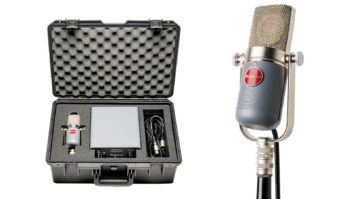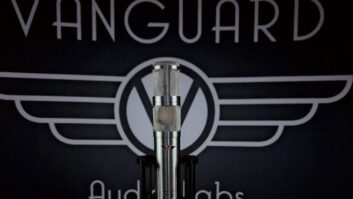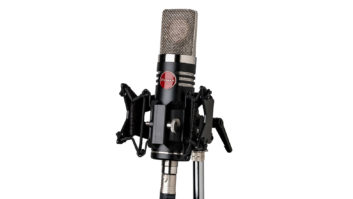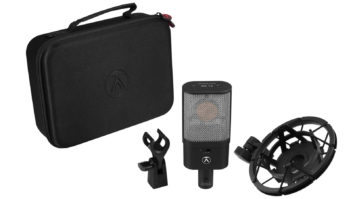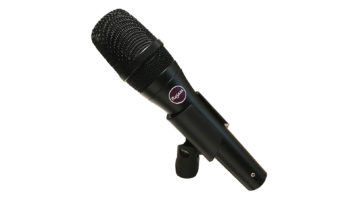While Dave Royer is still best known as the father of the modern ribbon microphone (Royer R-121), his internal alter-ego — operating under the Mojave Audio umbrella — continues to design and manufacture some of the best condenser and tube mics on the planet. Mojave has upped the microphone ante once again with its latest release, the large-diaphragm, multi-pattern MA-300. Mojave sent me a trio of these mics for the review period several months ago, and I’ve been using them nonstop ever since.
Features
The Mojave MA-300 is essentially a MA-200 with variable pickup pattern, bass roll-off and -15 dB pad. The large-diaphragm, vacuum tube, condenser microphone utilizes a hand-selected, double-diaphragm, gold-sputtered, three-micron capsule; Jensen audio transformer; and subminiature military-grade NOS (new old stock) JAN 5840 vacuum tube wired for triode operation. The low-noise 5840 is similar to the classic AC701K tube, and in addition to being used in the other tube Mojave mics, it is also used in the famed Royer R-122V tube ribbon microphone. The MA-300’s pickup pattern selector is continuously variable from omnidirectional to cardioid to figure eight and the bass roll-off provides -6 dB/octave attenuation with a 100 Hz corner frequency.
The MA-300 has a 20 Hz-20 kHz, ±3 dB frequency response and features a transformer-balanced output. The microphone accepts relatively high sound pressure levels and the documentation provides distortion levels at various SPLs (e.g. < 1% @ 117 dB SPL, < 3% @ 125 dB SPL with pad off, < 1% @ 132 dB SPL, < 3% @ 140 dB SPL with pad on). Smaller than most tube microphones power supplies, the MA-300’s supply is slightly larger than an average-sized DI, and it includes a gold-plated male XLR output, a multi-pin input for the mic’s 20-foot cable and a lighted on/off switch. An internal switch in the power supply allows the supply to be configured for 100, 115 or 230 Volts at either 50 or 60 Hz. Every MA-300 mic, power supply and cable set is burned in for 24 hours followed by meticulous testing and evaluation before leaving the factory to ensure that it is shipped in impeccable working order.
The MA-300 and its accessories are packed in a briefcase-size case that feels like it should easily hold up to the rigors of every day use. The foam is pre-cut to perfectly carry the power supply, cables and shock mount and the actual mic fits in a smaller case that also fits inside. The entire package weighs 13 pounds.
In Use
During my review period, I’ve had the opportunity to use these MA-300s on a wide variety of sound sources, and they absolutely failed to disappoint. The continuously variable pickup pattern is a godsend; it adds a whole new palette of sonic options beyond the MA-200. When I’m in a hurry with no time to experiment, I simply set the mic on my preferred pickup pattern and roll with it; if there’s time to experiment, I’ll place the power supply within reach of my monitoring position in the control room so I can dial in the best sound by sweeping the pickup pattern control (instead of relying on equalization) until the desired sound is attained.
If I’m working in a larger studio where the 20-foot mic cable doesn’t have the length needed to allow the power supply to live in the control room, I’ll have the assistant sit within its reach so he can tweak the pickup pattern knob until the magic tone is attained. Like the MA-200, the MA-300 has a rich, warm tone with enough sonic flexibility to work well with most vocals and instruments. Its high-frequency response is musical and open, and it provides a sound that rarely requires anything beyond subtle equalization (even in the mix).
I used a pair of the MA-300s along with a Sonic Farm Creamer preamplifier to capture overheads on a drum kit, and the results were fantastic. The mics worked equally well on toms and outside kick (with the pads engaged in both instances). The Gordon mic pre worked perfectly with the 300s to capture shaker and tambourine.
The MA-300s along with a pair of LaChapell mic preamps and a Tube-Tech CL2A did a wonderful job capturing a Taylor 514-CE guitar with one mic about 10 inches off the body and the other on the neck about six inches from the 12th fret. On another occasion, I used the mics in an M/S configuration with the mid mic (in cardioid) placed about 12 inches from the 12th fret and the side mic set to figure eight. The mic is fantastic on electric guitar. I typically had the best results when placed about eight inches from the speaker halfway between the center and the edge. This is one of the instances when the variable pickup pattern is wonderful, as you can hear the sound of the amp in the room vary based on the pickup pattern.
I was able to simultaneously use all three MA-300s while recording a horn section for the soundtrack to an Australian film, The Sapphires, and the mics worked superbly. The saxes were smooth and rich, never edgy; and the brass was full and round. I didn’t have the opportunity to use the MA-300 on strings, but based on my experience recording strings with the MA-200, I imagine it would work magnificently there, too.
The MA-300s wonderfully captured the sound of the grand piano with one mic placed over the high strings and one over the low (with the mics about five inches off the strings) and ended up with a fantastic sound. I also used the mics in an M/S configuration with the mics slightly outside the lid (which was raised to the highest position) and again had wonderful results, this time with a warmer tone, better suited for solo piano but not as good for a band track.
Even though the MA-300 is compatible with nearly any sound source, like the MA-200, I think its true strength is in recording vocals. The mic worked equally well capturing both male and female vocals, and in both instances I generally had the best results with the pickup pattern set to cardioid. It was nice having the option of using another pattern, though, and there were several instances (typically, when I was working in a fantastic-sounding room) when I found I preferred the omni setting. Vocals through the MA-300 sound rich and full without any negative proximity effect issues. From subtle and intimate to over-the-top aggressive, the mic sounds fantastic.
Summary
The Mojave Audio MA-300 is an amazing-sounding microphone that is well built, feature-packed and exceptionally priced; compared with the rest of the Mojave line, this kind of performance is becoming the company’s legacy. The MA-300 should receive top consideration from any engineer or studio looking to broaden its sonic palette.
Price: $1,295
Contact: Mojave Audio | mojaveaudio.com
Russ Long is a Nashville-based producer, engineer and mixer as well as PAR’s senior contributor.
